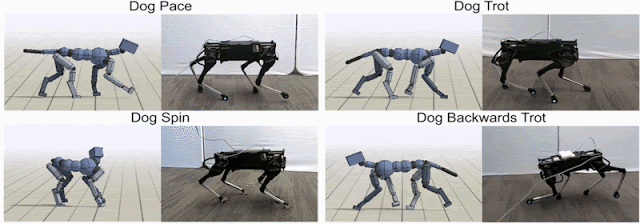How Google is teaching a robot dog to learn to move like a real dog
YOU KNOW ITS REAL WHEN IT LEARNS TO SNIFF BUTTS

A team of researchers at Google's AI lab is seeing results in its effort to develop a dog-like robot quadruped that learns dog behavior by studying how real dogs move. The team has posted an outline of the work they are doing on the Google AI blog.
Training a robot to perform tasks by mimicking the movements of a living creature is not new—robot arms that build cars, for example, are taught how to spot weld or tighten bolts by mimicking the desired action as performed by a human arm. But teaching a robot by showing it video of a real dog is definitely new. And that is just what Google is doing. The robot in this case is a quadruped called Laikago (after Laika, the first dog in space)—it is being trained to walk, run and even chase its tail like a real dog by showing it motion-capture footage of a real dog in action.
Training a robot to perform tasks by mimicking the movements of a living creature is not new—robot arms that build cars, for example, are taught how to spot weld or tighten bolts by mimicking the desired action as performed by a human arm. But teaching a robot by showing it video of a real dog is definitely new. And that is just what Google is doing. The robot in this case is a quadruped called Laikago (after Laika, the first dog in space)—it is being trained to walk, run and even chase its tail like a real dog by showing it motion-capture footage of a real dog in action.
In practice, the video is actually first processed by an AI system that translates the action in the video into an animated version of Laikago. To work out possible interpretation errors (because the digital dog is made from metal and wire and motors instead of bones, muscles and sinews), the team shows the AI system multiple stop-action videos of a real dog in action. The AI system builds up a toolset of possible moves depending on scenarios that might be encountered in the real world. Once the simulation has built up a knowledge base, its "brain" is uploaded to Laikago, who then uses what the simulation has learned as a starting point for its own behavior.
Video of Laikago in action shows that the technique works—the robotic dog is able to walk and trot very much like a real dog—and even simulates chasing its tail. But it also has some deficiencies compared to other advanced robotic animals, such as those from Boston Dynamics,which get their skills through programming—getting back on its feet after stumbling or tripping, for example, is still troublesome. But the researchers at Google are undaunted, believing more research will lead to ever more lifelike behavior by their robot.
More information: ai.googleblog.com/2020/04/expl … d-robot-agility.html
Learning Agile Robotic Locomotion Skills by Imitating Animals, arXiv:2004.00784 [cs.RO] arxiv.org/abs/2004.00784
No comments:
Post a Comment